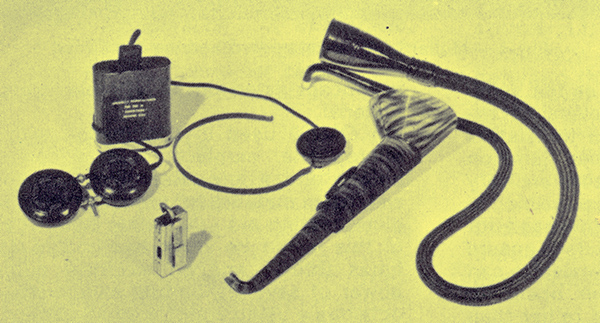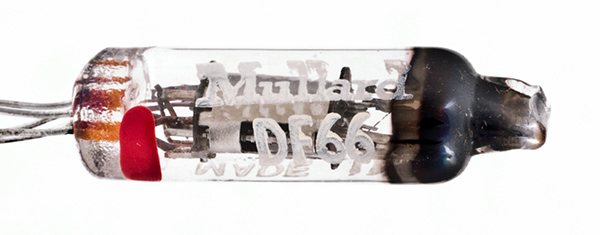|
A less well-known facet of Mullard activities is the subject of this article - devices for hearing aids. The Mullard interest in this specialised field extends back to pre-war days and in this short article we propose to trace briefly the development of devices from the early valves measuring 70 × 36 millimetres to the final D64 series valves.
Acoustical and Electrical Hearing Aids

Early Hearing Aids.
Many devices have been used over the years as aids to hearing. The earliest instruments, although taking many diverse means ranging from ear trumpets to acoustic chairs, were all based on the same principle. The wide end of a bent funnel was directed towards the source of sound and the resultant increased air pressure at the narrow end applied to the ear.
The first electrical hearing aid used a carbon granule microphone together with a battery and external magnetic-type earphone. Sound waves impinged on the diaphragm causing it to vibrate. Consequent changes in pressure on the carbon granules caused the tightness of packing to vary, hence varying the electrical resistance. The resultant changes in current were applied to an earphone to produce a reasonably true reproduction of the original sound at an amplified level. However, resonance in the microphone and receiver caused considerable distortion, the individual frequencies were unevenly amplified and a general background of noise was introduced by the components.
Electronic Amplifiers
The next development was the use of electronic amplifiers. The first of these consisted of a very bulky and heavy amplifier, a microphone, a head-band type external earphone, a rechargeable accumulator and a high-tension battery. The latter was housed in a separate compartment of the large container. These amplifiers which became available in the mid 1920's used three triode valves requiring an HT supply of 45 or 90 V together with a 1.5 or 2 V supply from primary or secondary cells for the heaters. The complete hearing aid fitted into a small case about 10 x 6 x 4 in and weighed about 10 lb.
Although portable, this was not wearable, and the power consumption was such that the batteries had to be constantly replaced and the heater accumulators recharged.
By the mid 1930's Mullard and a few other manufacturers had begun to produce smaller valves. These were some 50 mm long and 16 mm in diameter compared with the 70 x 36 mm of earlier valves. At the end of the 1930's, microphones and earphones had been produced which were smaller, more sensitive and lighter. Most ot the hearing aids sold in Britain at this time were suitable for wearing.
First Range of Sub-miniature Valves - D70 Range

Mullard DC70 Triode.
In subsequent years, Mullard made many significant contributions to the production of better amplifiers, with ranges of valves specially designed for use in hearing aids. The D70 range of pentode valves were capable of higher amplification than previous valves of this kind and the power consumption of the heaters of three D70 pentodes was reduced to 50 mA at 1.25 V.
The dimensions of these all-glass valves were considerably reduced, the input valves being 30 mm long and 10 mm in diameter and the output valve 38 mm long and 10 mm in diameter. The two pre-amplifier stages could give a gain of 2,500 times, and the DL72 valve gave a power output of 20 mW with a 45 V HT supply.
In the development of these first sub-miniature valves, several conflicting problems had to be solved. The filament had to be thin to reduce the power consumption but it had to have sufficient tensile strength to withstand heating to its normal operating conditions and mechanical shock. Microphony created a problem which was overcome by special tensioning of the heater to give a resonant frequency beyond the audible range. Mechanical damping was also used but care was needed not to cool the heater and thereby reduce the operating efficiency.
Still Smaller Valves - D66 and D64 Series

Mullard DF66 sub-miniature Valve.
To meet the demand for still smaller valves, Mullard produced a new series of subminiature valves for hearing aids. The heaters still operated from a 1.25 V dry-cell supply, but the current drawn by the two voltage-amplifying pentodes (type DF66) connected in series was reduced to 15 mA. The output pentode, type DL66, also drew 15 mA. The total drain was thus only about 30 mA - a 40% reduction in the LT power consumption compared with the D70 series. The HT supply could still be a 45 V battery as with the D70 series, but the D66 series valves would operate equally well from a 22.5 V supply. The D66 series gave a cascade gain of more than 1,200 times with a power output from the DL66 of 2.7 mW. The cross-dimensions of the DF66 voltage amplifying pentodes were just over 8 x 6 mm and the envelope was about 28 mm long. The cross-dimensions of the DL66 output pentode were 8 x 6 mm and the envelope length 35 mm.
As the demand for even smaller valves increased the D64 range was introduced. The DF64 pre-amplifying pentode measured only 7.2 x 5.6 x 25.4 mm and the DL64 output pentode measured 7.2 x 5.6 x 32.2 mm. These valves operated from a 15 V HT supply, and with total heater current now reduced to 20 mA, a power reduction of one-third compared with the D66 range was attained.
Hearing aids were now measuring about 3 x 2 x 0.5 in with a very much better performance than anything that had hitherto been achieved. They were, however, still rather bulky and two batteries were needed, one for the HT and one for the LT supply.
The development of valve based hearing aids ended with the D64 range and from then on semiconductors took over. - ed.
|